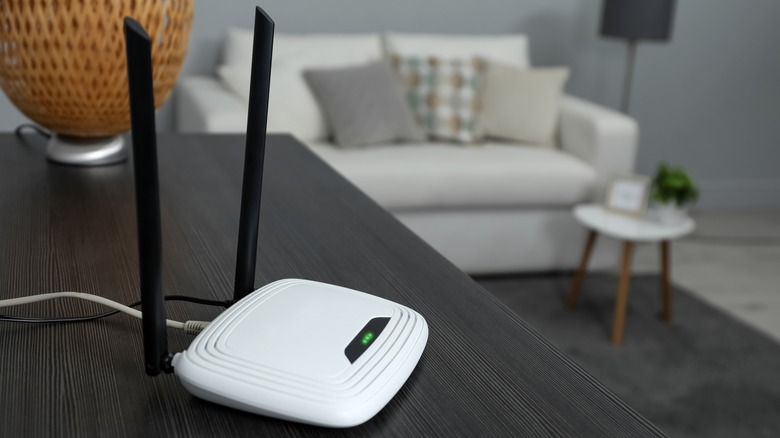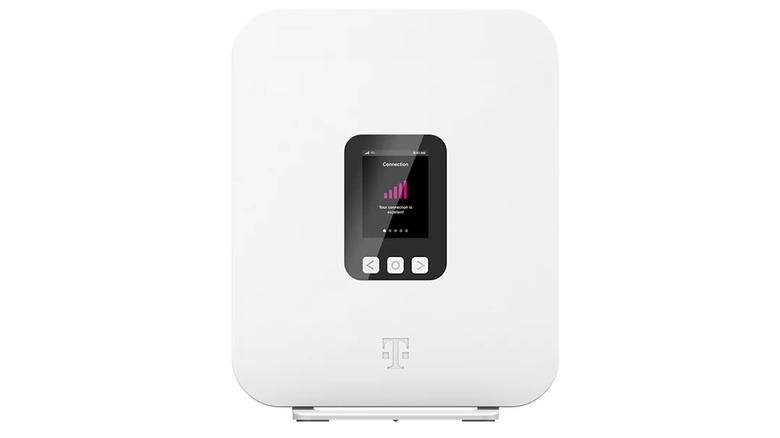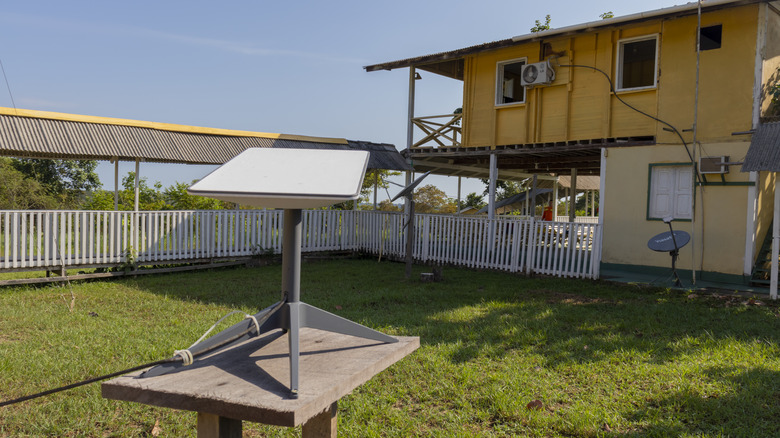T-Mobile Home Internet Away Vs Starlink Roam: Which Plan Is Best For You?
If you live somewhere somewhat remote, beyond where cable and fiber optic companies consider it worth running service to, then your options for broadband internet service are fairly limited. At that point, you can either go with a cellular internet from a carrier best known for mobile phone service or a satellite internet provider. Neither is perfect, with both having higher latency than fully hardwired broadband, but both technologies have seen major improvements in recent years, with the rise of 5G helping the cellular side and low-Earth orbit satellites improving satellite internet's response times, putting it in line with 5G.
However, if your use case involves frequently using the service away from your registered home address, then the leaders in this space require that you subscribe to a higher tier to use it on your frequent camping or RV trips. In particular, T-Mobile offers the T-Mobile Home Internet Away plan, while Elon Musk's Starlink offers satellite service for nomads in its Starlink Roam plan. Depending on your specific use case, especially what you're planning on using your internet connection for, each has positives and negatives over the other. This also goes for how much you have budgeted for your wireless internet service, as Starlink requires the purchase of expensive hardware while T-Mobile bundles its required access point. With all of that in mind, let's take a look at what each of these services have to offer and how they stack up against each other.
What is T-Mobile Home Internet Away?
T-Mobile Home Internet Away is a pricing tier available to customers of T-Mobile's home internet service, which utilizes a Wi-Fi router that connects to "the Un-carrier's" 5G network. Though it's priced competitively with the entry-level broadband offerings from the likes of Verizon Fios and the various cable company ISPs, anyone who has those available to them is not the ideal T-Mobile home internet customer. That's because a wired connection via a fiber-optic network or cable system is generally going to be faster and more reliable than T-Mobile's 5G connection. T-Mobile Home Internet gets the nod in areas where it's the cheapest option and/or wired broadband isn't available.
However, in April 2024, T-Mobile planted its flag in another use case: Those who spend much of their time camping, exploring the country in RVs, and the like. Technically, you could use T-Mobile's home internet routers to do this before, but the company considered it a violation of terms and conditions stating that the service had to be used at your registered home address. However, these violations weren't really enforced — so the same day that T-Mobile announced its T-Mobile Home Internet Away plan for nomadic customers, The Mobile Report revealed that T-Mobile was also set to start enforcing the home address rule. In practice, this meant that if you were already a roving T-Mobile Home Internet subscriber, your monthly bill went up from $50 to $160 (or $110 if you opted for a 200GB data cap instead of unlimited service).
What is Starlink Roam?
Of course, if you're constantly on the move and need a dedicated broadband connection, cellular internet isn't your only option — there's satellite internet. One of the leaders of that product category is Starlink, Elon Musk's broadband company. Starlink customers pay $599 for the required equipment, and then pay a monthly fee for the different service tiers: It's $139 per month for residential service, $174 per month for Starlink Roam (the "nomad" option), or $374 per month for boat service (which also requires considerably more expensive hardware at $3,740).
Starlink describes the Roam plan as being "Best for RVers, campers, and travelers throughout a continent." Its website also touts its simplicity, describing the setup process as plugging in the satellite dish and pointing it at the sky, and not necessarily in that order. The company also claims that its dish is weather-resistant, saying "it can melt snow and withstand sleet, heavy rain, and harsh winds," seemingly attempting to put at ease potential customers who have experience or heard of one of the more common pitfalls of other satellite-based services, like satellite-TV. Its frequently asked questions page also notes that customers need to opt-in to the metered Priority Data plan to be able to use Starlink while in motion, during which the vehicle that the dish is mounted on must be moving slower than 10 miles per hour.
Which has faster data transfer speeds and lower latency?
The most important point of comparison is raw performance, both in terms of the actual data transfer speeds and the level of latency/response time that's most important in video chat and online gaming. The latter has long been a significant differentiator that put cellular and especially satellite internet at a level below cable, DSL, or fiber optic connections. However, Starlink has improved significantly on that metric, in part because Starlink uses low-Earth orbit satellites, or LEO for short. SatelliteInternet.com's review of Starlink service clocks the ping time for latency at 25ms to 60ms for the "Standard" and "Priority" tiers, with the other tiers coming in under 90ms. The former is comparable to what Reddit users report for T-Mobile Home Internet.
According to SatelliteInternet's comparison of the two services, cellular internet service will usually have lower latency than satellite, even the LEO variation, particularly if you're close to a cell tower. It also offers higher maximum throughput, able to get up to about gigabit speeds compared to 220Mbps for Starlink. So if you're intending to use your connection for pretty frequent online gaming, video chat, and/or, to a somewhat lesser extent, video streaming, then T-Mobile Home Internet is the superior option. But their comparative performance is close enough that if other factors drive you towards Starlink, you shouldn't worry about having made the wrong decision for your use case.
Startup costs
This one is pretty cut and dry: If you're looking to save money on upfront costs, then T-Mobile Home Internet has a massive advantage over Starlink. With T-Mobile, the required Wi-Fi Mesh Access Point is included at no cost. With Starlink, the costs are a lot higher, as you're paying at least $599 for the required hardware before you pay for any monthly service fees. If you want the more sophisticated hardware that can access more satellites at once so you can get consistent service while in motion, you're gonna be out $2,500.
If you're on any kind of budget, like if you're trying to really stretch the money you've allotted for this journey that requires a nomadic internet plan, then the choice is obvious here. T-Mobile Home Internet is the way to go, especially if you need service while your car/truck/RV is in motion. The exception would be if you're going to be traveling through areas where T-Mobile coverage is spotty, in which case you have to decide if the significant hardware costs are worth it to have a more consistent internet connection.
Data caps
T-Mobile Home Internet doesn't have any kind of data caps if you're on an unlimited plan, so you don't have to worry about your service degrading after a certain amount of usage during each billing cycle. Starlink, however, is a bit more opaque about how its plans work. Its service plans page alludes to a concept of priority data on its Roam and Boat plans, and the pricing is explained clearly for the Boat tier, but for Roam, it just says that "Mobile Priority Data available by the GB."
Going by SatelliteInternet's Starlink review page, the tangible benefits of the ISP's Priority Data is that its throughput bottoms out around 40 megabits per second and tops out at 220 megabits. Non-priority service, meanwhile, runs from either 20 to 100 megabits per second or 5 to 50 megabits per second depending on the plan. Basically, this varies by the plan, but overall, it's an area where T-Mobile comes ahead thanks to its complete lack of caps on its "unlimited" plan.
The Final Verdict
When all is said and done, we have to acknowledge that this is a pretty extreme outlier of a use case. We're not just talking about the base service that T-Mobile Home Internet and Starlink offer for rural customers, even if that's part of the equation of which choice you'll make. Instead, we're specifically looking at what they offer customers who are looking to use the service away from a fixed home address for extended periods of time. It's a niche within a niche, which means that it's far from a one size fits all scenario. As a result, coming up with anything resembling a bottom-line recommendation is incredibly tricky.
Purely on a dollar value basis, T-Mobile comes ahead with its lower subscription prices and bundling of its hardware for free, as opposed to Starlink requiring the purchase of hardware that costs as much as several months' worth of subscription fees. If you're trying to carefully budget for whatever adventure you're planning, T-Mobile the obvious choice. But it's also not that simple: T-Mobile's coverage, though excellent, has gaps, and those gaps include wide swaths of land in areas where the hypothetical RV camper/adventurer might gravitate to. If the white spots on the T-Mobile coverage map come even close to areas you're interested in traveling to, then T-Mobile Home Internet Away is not necessarily a good option. As a satellite-based service, Starlink doesn't have those kinds of big coverage gaps, making it the superior choice the further off the grid you go.
Overall? If all else is equal, you're probably best off with T-Mobile. But if you're planning on visiting very remote areas, you need Starlink.






